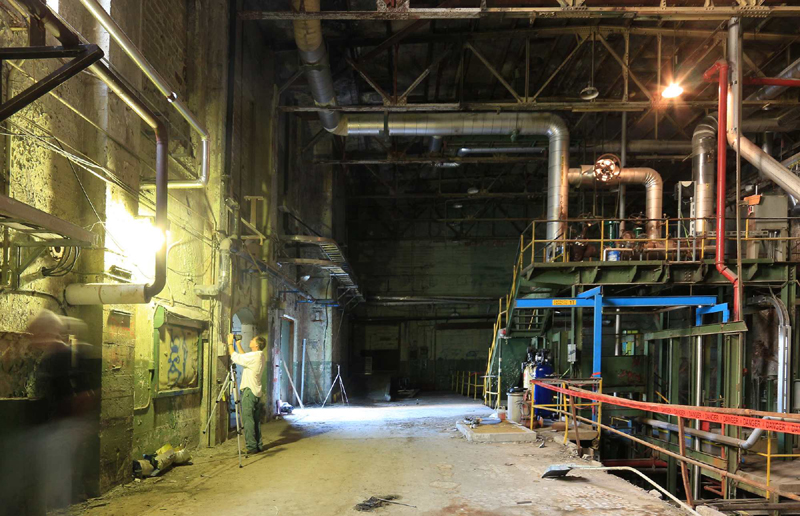After many hours of photography, videography and documentation, the end of the day for the WHM volunteers at the former E. B. Eddy mill is something of a ritual. The equipment is gathered, caravanned back to the storage office, and everyone seats themselves on chairs around a conference table that once hosted planning sessions for mill managers and engineers. While the WHM representative gathers everyone’s log sheets and transfers data from multiple camera memory cards to a laptop, around him the tired but satisfied volunteers exchange stories.
“Did you see the glowing moss in that tunnel?”
“Remember the raccoon you saw looking through the cargo door last week? Well, one of his cousins left his prints all over the palette of cardboard in 502!”
“You know the control panel for the roll processor I spent all morning detailing? The digital read-outs kept changing! I finally figured out that the floor plate was a scales taking my weight – accurately, I might add. Pretty amazing considering that it was probably designed to weigh half-ton paper rolls!”
The light outside is dimming as the WHM rep sees off the last of the volunteers, advises the Domtar office the building is secured, nods to the night guard just coming on shift, and departs himself, already mentally planning where the team will deploy for the next scheduled day.
Even after all of the many buildings that comprise the former mill complex have been fully recorded – optimistically by late 2015 – it will be, as Winston Churchill said, just the end of the beginning. It is expected that around 100,000 images and hundreds of video clips will emerge from this effort, to become a part of WHM’s collection. The WHM Photographer will, over months or years, re-catalogue, index, and extract sub-categories of whatever images seem likely to be most useful and in demand. In recognition of the exemplary support and encouragement provided by Windmill Corporation, the project’s images will also be available for their promotional and other uses. Similarly, in recognition of their hard work and selfless hours of contribution to history preservation, the photographers will be granted license, if they request it, to the images they have taken.

A vast circulatory and nervous system for an enterprise, many of the conduits for steam, water, electricity and data still enlace the walls, floors, and ceilings.
WHM is already planning ways to use this new resource. It is in touch with the Canada Science and Technology Museum, which holds artifacts and archives donated to them by E. B. Eddy Corporation, and is planning a number of travelling and permanent displays, some of which may be housed in the public areas of the Windmill development itself. Another intriguing possibility is a coffee table book and gallery exhibits, since many of the images, quite apart from their historical value, are works of art in themselves. In a separate endeavour, Carleton University architecture students are using sophisticated laser scanning technology to precisely record the interiors in three dimensions, and WHM will approach them to see if its images can be overlaid to permit an online virtual walk-through of the buildings long after they have disappeared or been remodelled.
All that too is only the start. We have no way to predict what value may be mined from those images in the future. Who knows what may interest researchers a century or two from now? Much of the detail our teams record is mundane and unremarkable to us today – we know what an electrical outlet looks like – but will there even be such things in 50 or 100 years? If someone wants to know what late 20th-century industrial fire-suppression systems looked like, WHM’s collection may be one of the few places where multiple examples can be reviewed. The E. B. Eddy mill portion of the WHM collection could benefit social historians, but also students of technology, cinematographers, educators, and fields of study that do not yet exist.
All of this is made possible by far-sighted and energetic volunteers, so let me end this series with an appeal. If you are a keen photographer or someone willing to devote a day or two a week to the endeavour I’ve described, contact me. We are working Mondays and Thursdays at present, but expect to organize a Saturday or Sunday team soon. Send an email to images@localhost:8080, and I will provide you with a detailed package on what the work involves and minimum camera specifications.
By Paul Harrison, WHM Official Photographer


